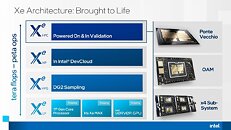
Intel Open Image Denoise v2.2 Adds Metal Support & AArch64 Improvements
An Open Image Denoise 2.2 release candidate was released earlier today—as discovered by Phoronix's founder and principal writer; Michael Larabel. Intel's dedicated website has not been updated with any new documentation or changelogs (at the time of writing), but a GitHub release page shows all of the crucial information. Team Blue's open-source oneAPI has been kept up-to-date with the latest technologies—not only limited to Intel's stable of Xe-LP, Xe-HPG and Xe-HPC components—the Phonorix article highlights updated support on competing platforms. The v2.2 preview adds support for Meteor Lake's integrated Arc graphics solution, and additional "denoising quality enhancements and other improvements."
Non-Intel platform improvements include updates for Apple's M-series chipsets, AArch64 processors, and NVIDIA CUDA. OIDn 2.2-rc: "adds Metal device support for Apple Silicon GPUs on recent versions of macOS. OIDn has already been supporting ARM64/AArch64 for Apple Silicon CPUs while now Open Image Denoise has extended that AArch64 support to work on Windows and Linux too. There is better performance in general for Open Image Denoise on CPUs with this forthcoming release." The changelog also highlights a general improvement performance across processors, and a fix that resolves a crash incident: "when releasing a buffer after releasing the device."
Non-Intel platform improvements include updates for Apple's M-series chipsets, AArch64 processors, and NVIDIA CUDA. OIDn 2.2-rc: "adds Metal device support for Apple Silicon GPUs on recent versions of macOS. OIDn has already been supporting ARM64/AArch64 for Apple Silicon CPUs while now Open Image Denoise has extended that AArch64 support to work on Windows and Linux too. There is better performance in general for Open Image Denoise on CPUs with this forthcoming release." The changelog also highlights a general improvement performance across processors, and a fix that resolves a crash incident: "when releasing a buffer after releasing the device."

















